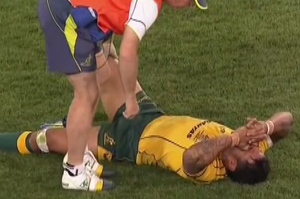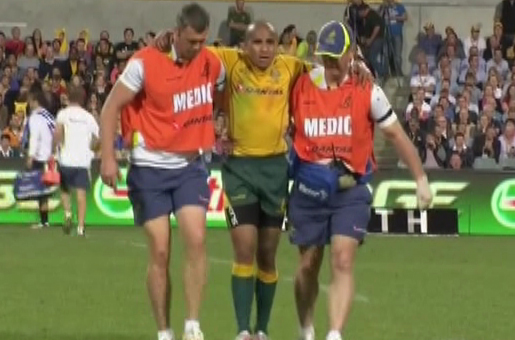As Wallabies supporters we all want the best performance possible from our team. Whether you think the Wallabies’ performances this year justify a pass mark or not, I doubt there are many people who feel we saw the best of the Wallabies in 2012.
The first step in improving performances going forward is to look backwards to identify the reasons that stopped expectations being met.
In looking backwards we have to be careful to identify reasons and not excuses. Reasons are logical explanations supported by facts, whereas excuses are an attempt to justify outcomes by shifting blame to others, or to seemingly uncontrollable events, when there is a lack of progress or when something has not gone well.
Whether we’re talking about sport or life in general, excuses are quite often paraded as reasons and accepting excuses means you’re less likely to identify the real reasons behind less than optimal performance. Accepting excuses means you’ll repeat many of the mistakes caused by the real underlying reasons and fall short of achieving your best in the future.
Workload and the injury toll have been accepted by most of us as a reason for some of the Wallabies’ poor performances in 2012.
There is no question the Wallabies have suffered many injuries to key players. You have to ask what caused these injuries to occur – workload, poor preparation or bad luck? I don’t think it’s possible to identify an answer without much more information than we as spectators and commentators have, and indeed it may be a combination of all or some of those factors, plus others I’ve not identified. I think you’ve got to say injuries are a reason that should be taken into account when reviewing the Wallabies’ performances in 2012.
What about workload? Surely that’s a reason — after all, the Wallabies have now played 17 matches since the conclusion of the Rugby World Cup last year. Add in Super Rugby matches and there’s no doubt that some players must have suffered from fatigue during the year. The All Blacks acknowledged fatigue was becoming a factor during their end of year tour, and they’ve played three fewer matches than the Wallabies since the RWC.
But there’s an inconvenient truth for those offering workload as a significant reason that explains some of the Wallabies’ poor performances: by almost any measure, the All Blacks have endured a higher workload than the Wallabies. If, despite a higher workload, the All Blacks can perform at the level they have in 2012 maybe the Wallabies’ workload should not be accepted as being such a significant factor.
 How is it possible that the All Blacks have a higher workload than the Wallabies? Well, forget the number of matches played – a team is a group of players and the players in the team change regularly for a number of reasons, so let’s not look at the workload of a team and instead let’s look at the workload of the players. Whilst the Wallabies played more minutes of rugby as a team, the workload was spread over more players, reducing the workload on individual players.
How is it possible that the All Blacks have a higher workload than the Wallabies? Well, forget the number of matches played – a team is a group of players and the players in the team change regularly for a number of reasons, so let’s not look at the workload of a team and instead let’s look at the workload of the players. Whilst the Wallabies played more minutes of rugby as a team, the workload was spread over more players, reducing the workload on individual players.
How many times have you heard or read that the Wallabies used 40 different players in 2012? Did you know that despite playing one less match the All Blacks used 35 different players in 2012?
Dig a little further into those numbers and we find there were five Wallabies who played only one match in 2012. Four of those were in the mid-week match against Scotland and the other was James Hanson who played 13 minutes off the bench against the All Blacks. So whilst those players played for the Wallabies, you’d hardly expect them to have suffered from a heavy international workload. So that makes it 35 players who played multiple games for the Wallabies in 2012. Similarly, the All Blacks had two players with minimal involvement – Hika Elliot with only one game off the bench and Tawera Kerr-Barlow with two games off the bench (34 minutes in total) — so that’s 33 players who played multiple games for the All Blacks in 2012.
Given the one extra match played by the Wallabies the number of players used by the Wallabies in 2012 is virtually the same as the All Blacks. So whilst the Wallabies will gain some benefit in the future through more players having had a taste of international rugby in 2012, the All Blacks will similarly benefit.
Despite playing one additional match in 2012 the Wallaby players averaged 455 minutes played in international matches during the year compared to an average of 483 minutes for the All Blacks players — a six per cent higher workload for All Blacks players.
Similarly the Wallaby players averaged 941 minutes played during the Super Rugby season compared to an average of 1,027 minutes played during the Super Rugby season by the All Black players – a nine per cent higher workload for All Black players.
The 15 All Blacks who played most regularly in 2012 had a slightly higher average playing time in the international matches than the 15 Wallabies who played most — an average of 776 minutes for the Wallaby players and 805 minutes for the All Blacks. These 15 players for each team played a very similar amount of Super Rugby in 2012 – an average of 1,064 minutes for the Wallaby players compared to 1,031 minutes by the All Black players.
If we look at the 22 players used most regularly by both teams the workload is still very similar as shown in the following tables – an average of 676 minutes for the Wallaby players compared to 682 minutes for the All Blacks. Those 22 players also averaged very similar Super Rugby minutes in 2012 – 1,041 for the Wallabies to 1,035 for the All Blacks.
| Player Name | Matches Played – 2012 Internationals | Minutes Played – 2012 Internationals | Minutes Played – 2012 Super Rugby |
| Nathan Sharpe | 15 | 1,178 | 1,211 |
| Adam Ashley-Cooper | 13 | 1,005 | 1,290 |
| Berrick Barnes | 13 | 909 | 1,098 |
| Digby Ioane | 13 | 895 | 875 |
| Kurtley Beale | 12 | 858 | 741 |
| Michael Hooper | 13 | 803 | 1,072 |
| Benn Robinson | 14 | 776 | 1,186 |
| Dave Dennis | 15 | 754 | 1,195 |
| Tatafu Polota-Nau | 12 | 740 | 929 |
| Scott Higginbotham | 12 | 723 | 1,220 |
| Ben Alexander | 12 | 678 | 1,056 |
| Nick Phipps | 9 | 603 | 1,083 |
| Sitaleki Timani | 9 | 596 | 451 |
| Pat McCabe | 8 | 582 | 1,185 |
| Will Genia | 7 | 545 | 1,370 |
| Wycliff Palu | 8 | 536 | 728 |
| David Pocock | 6 | 484 | 1,137 |
| Ben Tapuai | 6 | 463 | 591 |
| James Slipper | 12 | 461 | 1,245 |
| Stephen Moore | 10 | 439 | 1,225 |
| Sekope Kepu | 9 | 427 | 925 |
| Nick Cummins | 6 | 424 | 1,085 |
| Average Per Player | 676 | 1,041 |
Those numbers really confirm how impressive Nathan Sharpe’s performance was in 2012.
| Player Name | Matches Played – 2012 Internationals | Minutes Played – 2012 Internationals | Minutes Played – 2012 Super Rugby |
| Richie McCaw | 13 | 1,025 | 662 |
| Sam Whitelock | 14 | 977 | 1,244 |
| Israel Dagg | 13 | 962 | 1,303 |
| Kieran Read | 12 | 927 | 906 |
| Owen Franks | 13 | 837 | 915 |
| Tony Woodcock | 12 | 831 | 760 |
| Cory Jane | 11 | 823 | 894 |
| Conrad Smith | 11 | 803 | 1,256 |
| Aaron Smith | 13 | 787 | 949 |
| Liam Messam | 11 | 774 | 1,365 |
| Ma’a Nonu | 10 | 741 | 1,051 |
| Julian Savea | 9 | 694 | 1,019 |
| Dan Carter | 9 | 685 | 1,002 |
| Brodie Retallick | 13 | 657 | 1,346 |
| Andrew Hore | 12 | 547 | 788 |
| Luke Romano | 11 | 540 | 1,066 |
| Hosea Gear | 6 | 489 | 1,280 |
| Keven Mealamu | 10 | 468 | 421 |
| Aaron Cruden | 11 | 421 | 1,444 |
| Sonny Bill Williams | 5 | 405 | 1,424 |
| Piri Weepu | 13 | 316 | 654 |
| Ben Smith | 10 | 304 | 1,028 |
| Average Per Player | 682 | 1,035 |
Now to the numbers for all matches since the conclusion of the Rugby World Cup last year. The Wallabies played two matches on their end of year tour when most other players were putting their feet up. Those extra two matches mean that the Wallabies have played 17 matches in the twelve month period compared to 14 for the All Blacks, and that tour has been widely claimed as a cause of much of the fatigue the Wallabies suffered in 2012.
No doubt the extra matches and travel wouldn’t have been a benefit to the Wallaby players but even including those extra matches the average minutes played by Wallaby players in the twelve month period is 449 minutes compared to the average of 483 minutes for All Black players – eight per cent higher than the Wallabies. Despite playing two more matches, the Wallabies used an additional six players on that tour who didn’t play matches in 2012 so the workload was spread over more players.
Whilst the players on the 2011 end of year tour played two extra matches only 18 of the 40 players used by the Wallabies in 2012 also played on that end of year tour.
Trying to correlate the workload of players with injuries is difficult – Nathan Sharpe was the only Wallaby who played all 17 matches in the 12 month period and had one of the higher workloads of all Wallaby players in Super Rugby during 2012 yet was virtually injury free whilst other players who played for the Wallabies but didn’t play anywhere near as much rugby suffered from injuries.
The better performances by the All Blacks can be partially explained by the talent of their players and by the injuries to key Wallabies. Those are reasons, not excuses.
The inconvenient truth for those promoting the claim that the Wallabies had a higher workload than any other team in the world in 2012 which explains some of the Wallabies poor performances is that the numbers don’t support that claim.
The Wallaby players will again have a heavy workload in 2013 – in fact if there are fewer injuries next season it’s likely that the top 30 players in Australia will play more minutes for the Wallabies than they did in 2012.

